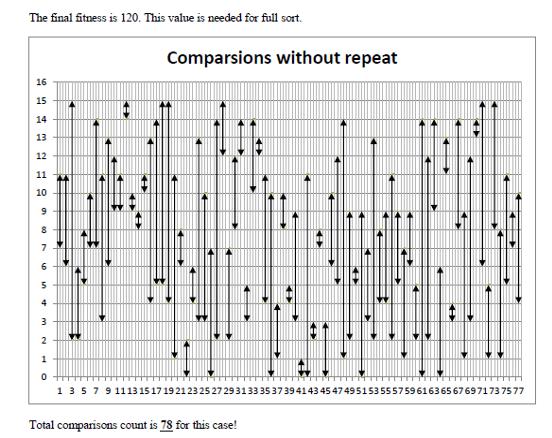Brest State Technical University, Course "Contemporary Intelligent Information Technology (CIIT)"
From students' works (2014)
 All One Problem
All One Problem
 Start with random 50 chromosome each with 1000 genes - An example of result ... By Vechorko Anna
Start with random 50 chromosome each with 1000 genes - An example of result ... By Vechorko Anna
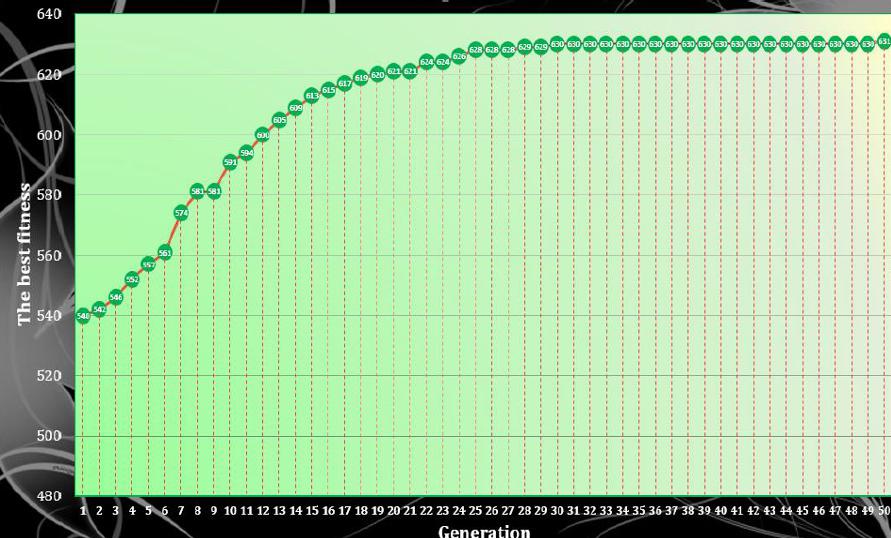
 1000 genes seem to be too big to converge to all one chromosome!
1000 genes seem to be too big to converge to all one chromosome!
 Then what is the maximum number of genes that enables evolution to converge so that all genes are "1"
Then what is the maximum number of genes that enables evolution to converge so that all genes are "1"
An example of result ... By Belous Sophia
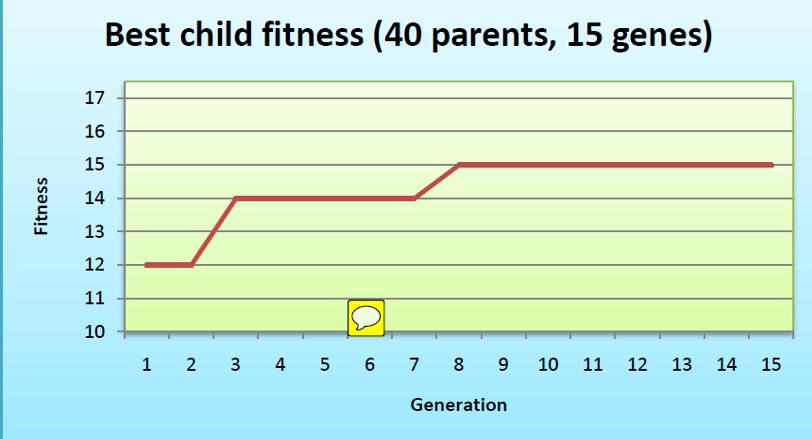
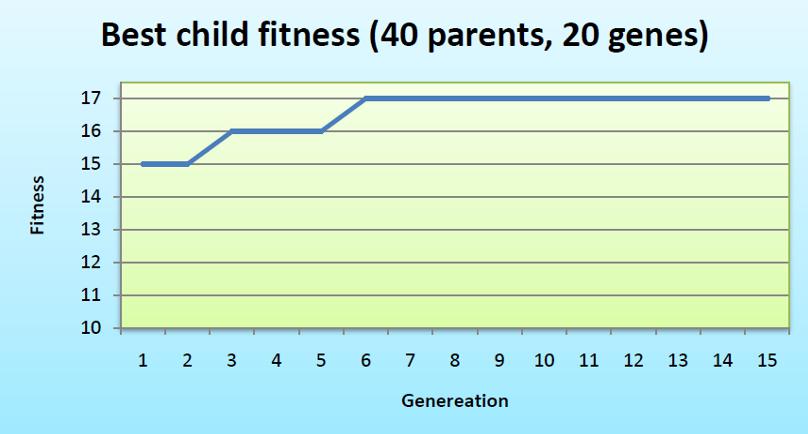
 Important message of this result is maximum number of genes that enable to evolve perfect all-one chromosome is 17. When the number of genes is 20, it's no more possible to all-one chromosome.
Important message of this result is maximum number of genes that enable to evolve perfect all-one chromosome is 17. When the number of genes is 20, it's no more possible to all-one chromosome.
 Or apply mutation to again 1000 genes chromosomes ... By Aliaksandra Kivachuk
Or apply mutation to again 1000 genes chromosomes ... By Aliaksandra Kivachuk

 By applying mutation, we obtained a perfectly good chromosome even with number of genes being 1000 and for population 50 again (Collection: x-axis is not "generate" but "generation")
By applying mutation, we obtained a perfectly good chromosome even with number of genes being 1000 and for population 50 again (Collection: x-axis is not "generate" but "generation")
 Lucky Dog
Lucky Dog
 Lucky dog problem in gridworld (0,0)-(1000,1000) with dog house at (500,500) and sausage at (200,800)
Lucky dog problem in gridworld (0,0)-(1000,1000) with dog house at (500,500) and sausage at (200,800)
An example of result ... By Vechorko Anna
(i) 10 random courses at the 1st generation; (ii) fitness vs generation, and (iii) The course of lucky dog in the final generation

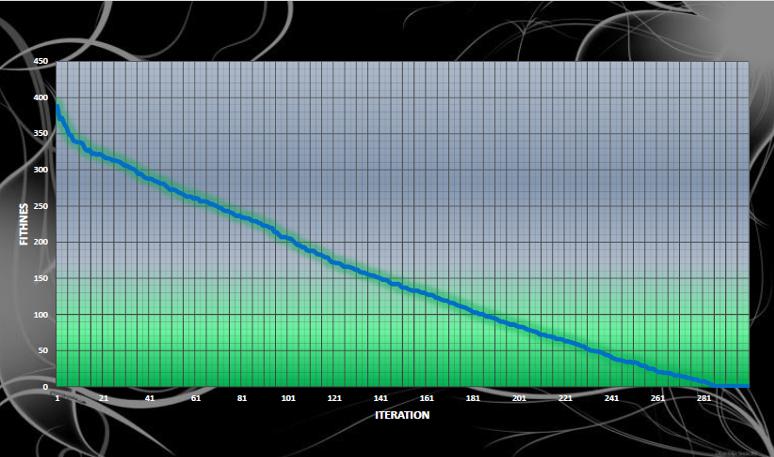
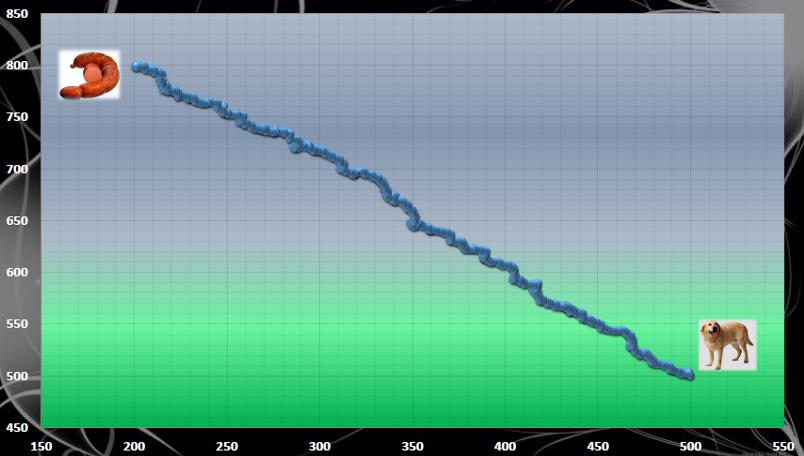
 Lucky dog problem in the same gridworld as above except for two sausages this time at (200,800) and (800,200)
Lucky dog problem in the same gridworld as above except for two sausages this time at (200,800) and (800,200)
An example of result ... By Belous Sophia
(i) Fitness vs generation, and (ii) The course of lucky dog in the final generation

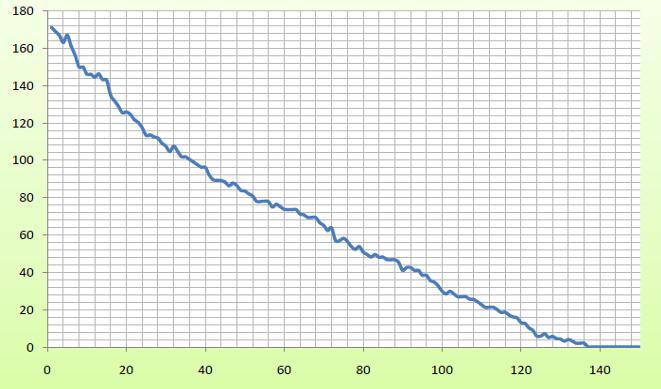
 Important message of the result is, all the dogs arrive to only one sausage despite that two sausages exsist.
Important message of the result is, all the dogs arrive to only one sausage despite that two sausages exsist.
 Lucky dog problem with one sausage again but this time dog should avoid a dangerous river (400,400)-(400,600)-(600,600)-600,400)
Lucky dog problem with one sausage again but this time dog should avoid a dangerous river (400,400)-(400,600)-(600,600)-600,400)
An example of result ... By Sanchuk Aleksandr
(i) Fitness vs generation, (ii) The course of some dogs who didn't die and (iii) the route of luckiest dog in the final generation
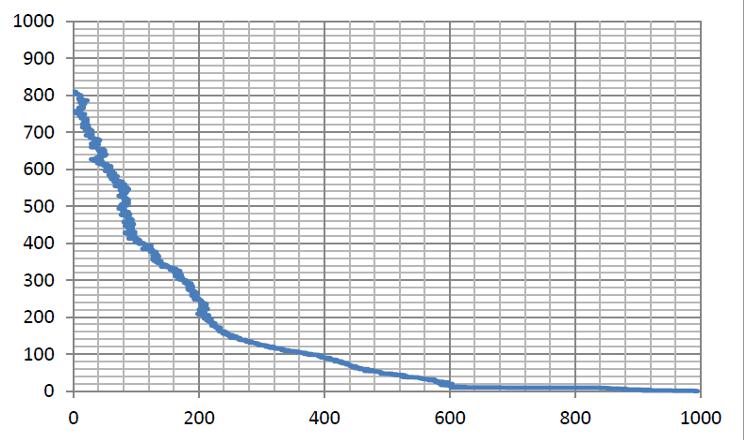
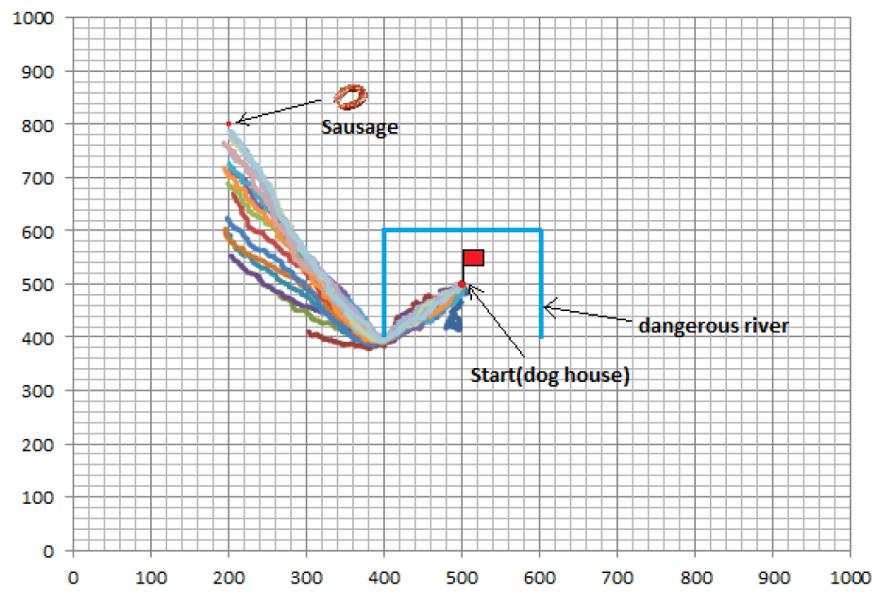
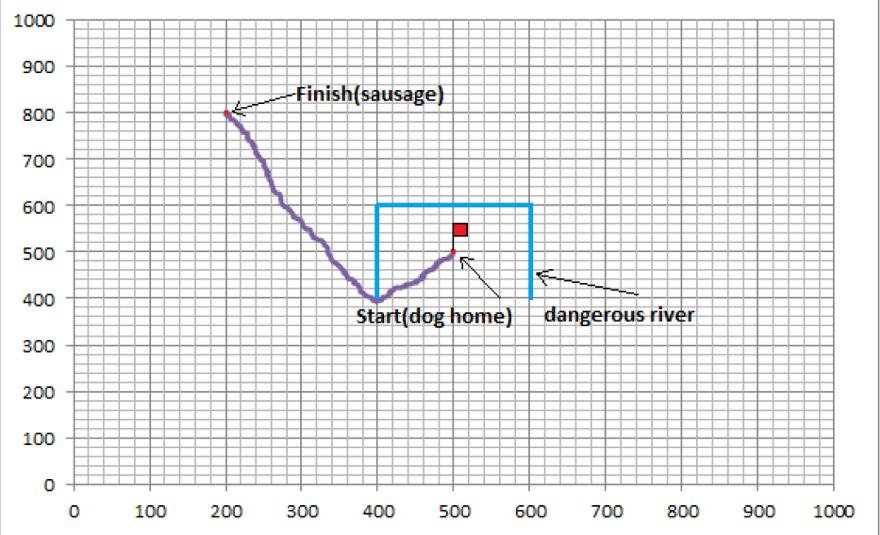
The other examples of the luckiest dog in the final generation
(i) Left ... By Aliona Radchuk and (ii) Right ... By Dmitry Verenich
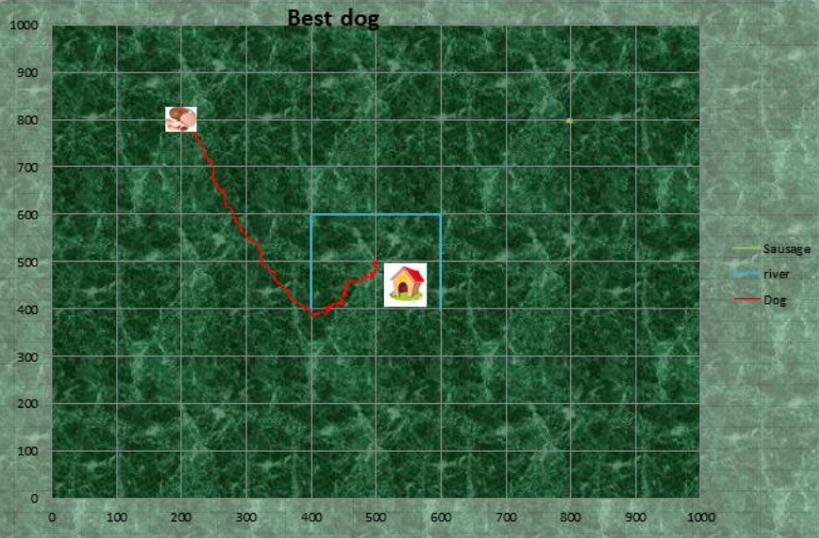
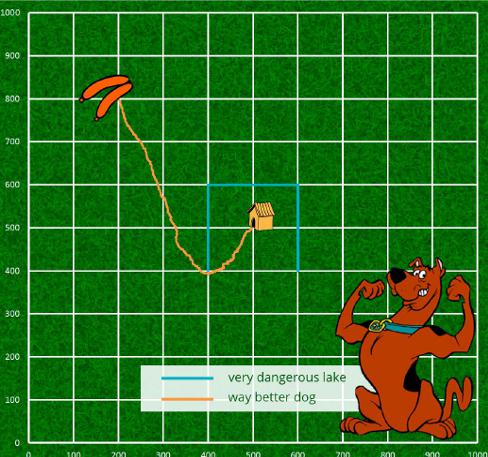
 Lucky dog problem with four sausages this time at (200,200), (200,800), (800,800) and (800,200)
Lucky dog problem with four sausages this time at (200,200), (200,800), (800,800) and (800,200)
An example of result ... By Marchanka Ilya
(i) Fitness vs generation, (ii) The courses of some dogs in almost the final generation (iii) the route of luckiest dog in the final generation
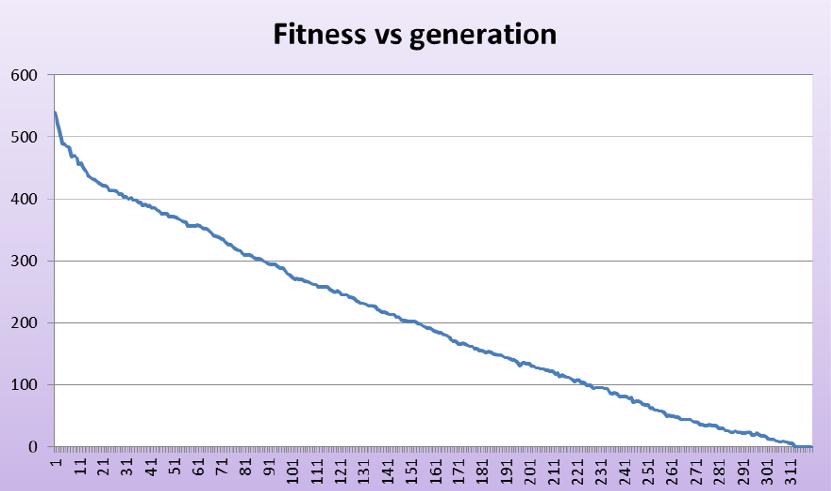
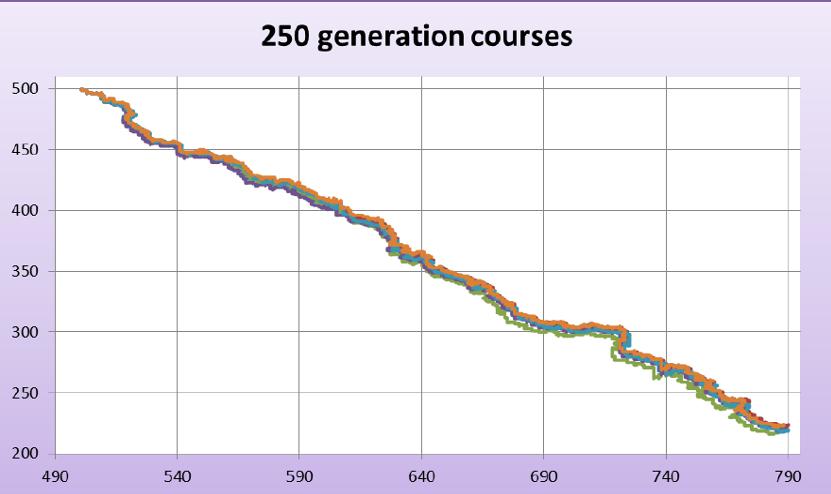
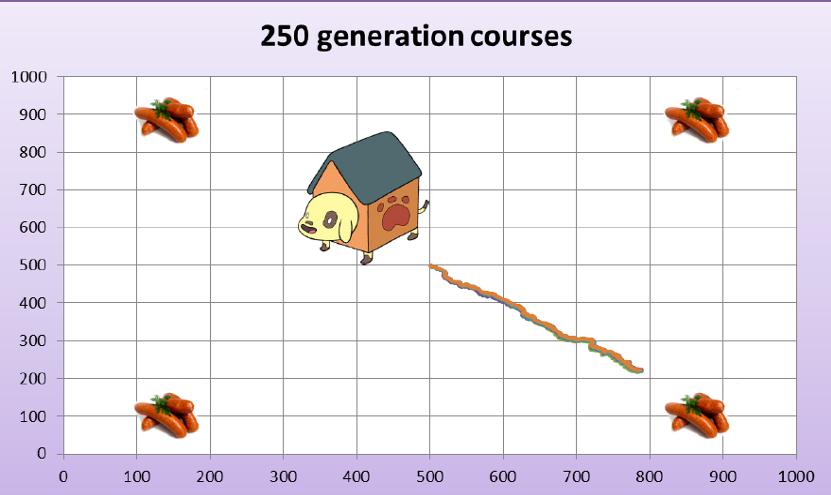
 Despite of 4 sausages, all the dogs evolved to reach only one of the four sausages.
Despite of 4 sausages, all the dogs evolved to reach only one of the four sausages.
 2-D Function minimization
2-D Function minimization
 Y = sin^4 (2*pi*x) where 0<=x<=1
Y = sin^4 (2*pi*x) where 0<=x<=1
An example of result: fitness vs. generation
(i) Left ... By Sobolev Igor and (ii) Right ... By Vechorko Anna
 Note that y-axis is average fitness. Therefore fitness = 1 means all the chromosomes reach to the solution.
Note that y-axis is average fitness. Therefore fitness = 1 means all the chromosomes reach to the solution.
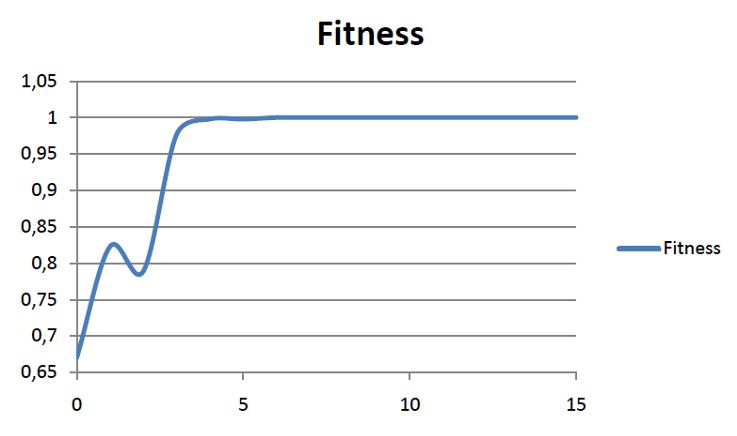
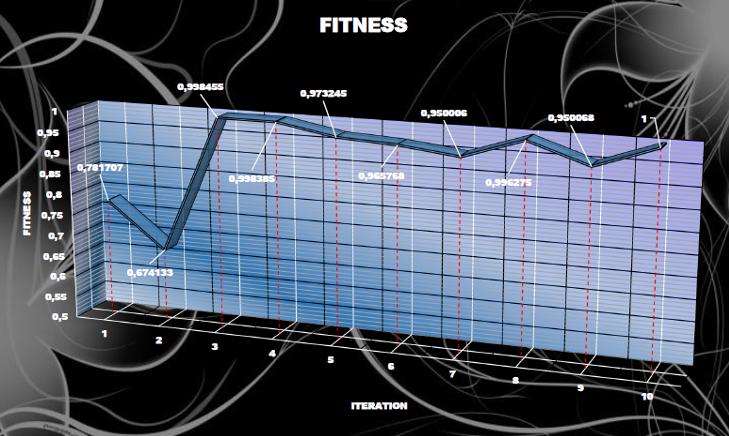
 Evolution looks very easy
Evolution looks very easy
Then how these chromosome moves from generation to generation? ... By Vechorko Anna
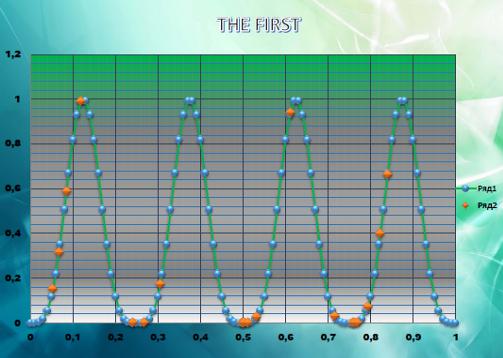
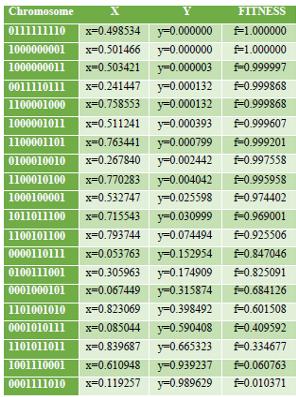


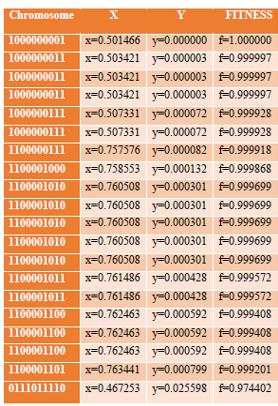

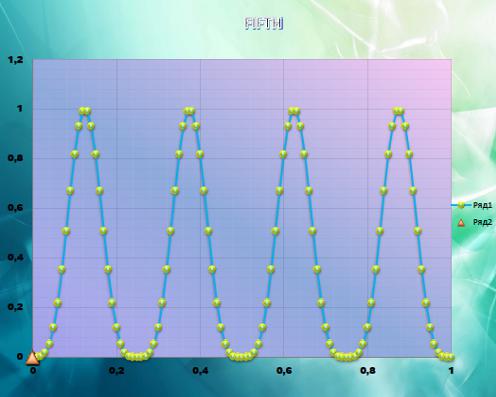
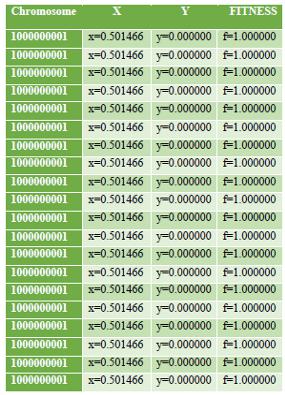
 All chromosomes evolved to reach only one solution despite that 5 solutions exists
All chromosomes evolved to reach only one solution despite that 5 solutions exists
 What if two, for example, fitness functions? - Parete Optimum Solution
What if two, for example, fitness functions? - Parete Optimum Solution
 y=(x-2)^2 and y=(x-4)^2 for x from 0 to 6 with an algorithm using "rank"
y=(x-2)^2 and y=(x-4)^2 for x from 0 to 6 with an algorithm using "rank"
An example of result ... By Magomedova Aminat
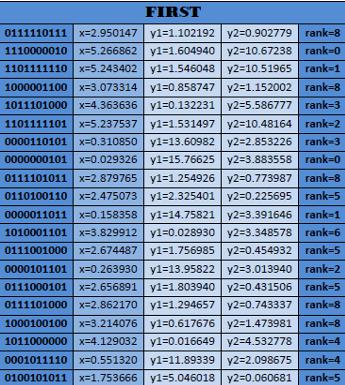
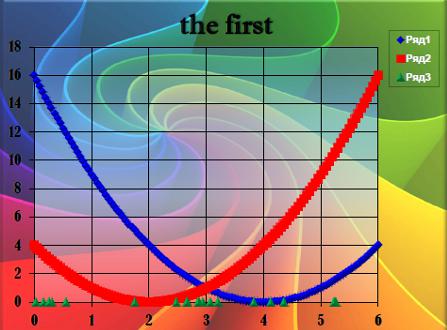

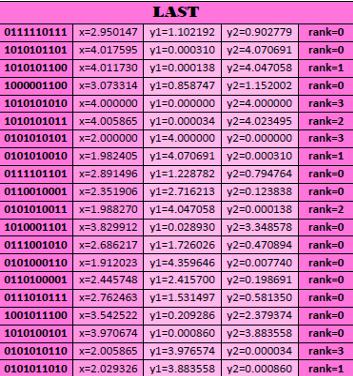
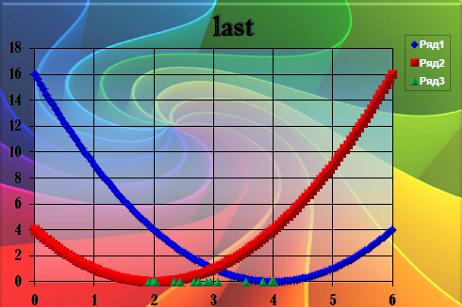
 Wondering how many generation was necessary to the final population?
Wondering how many generation was necessary to the final population?
 Traveling Salesparson Problem
Traveling Salesparson Problem
 With 6 cities A,B,C,D,E,F (starting A and return to A again after visiting all the other cities only once.)
With 6 cities A,B,C,D,E,F (starting A and return to A again after visiting all the other cities only once.)
An example of result: fitness vs. generation ... By Belous Sophia
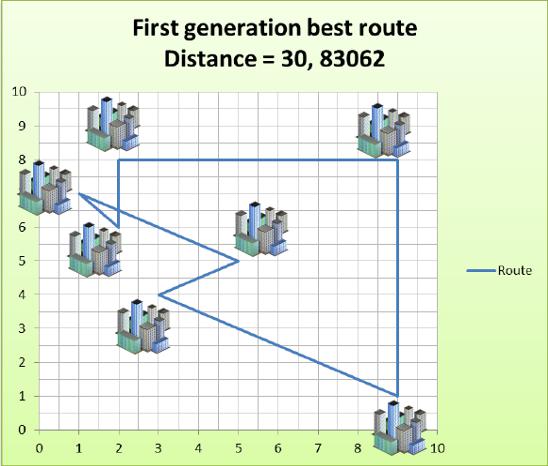


 Good work, but it includes a mistake that one city in the last generation changes its location from the 1st generation
Good work, but it includes a mistake that one city in the last generation changes its location from the 1st generation
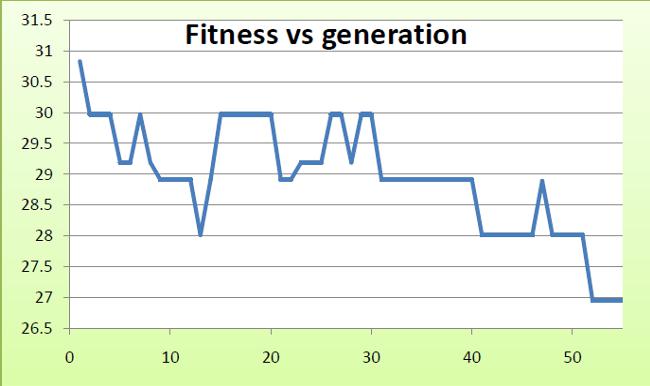
As additional work, all the possible 6!/2=360 routes were calculated. Only the part is shown here, though.
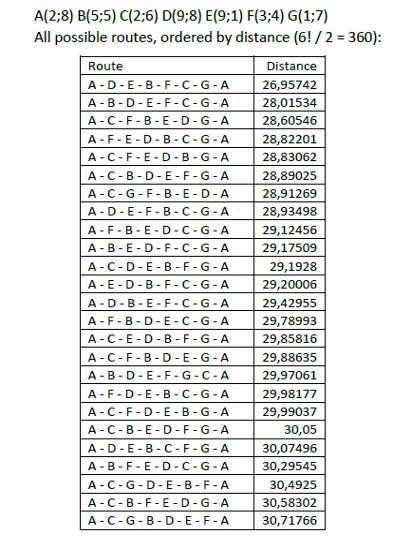

 5-even-Parity Problem by 5-5-1 Feedforward Neural Network
5-even-Parity Problem by 5-5-1 Feedforward Neural Network
 An example of result ... By Radchuk Aliona
An example of result ... By Radchuk Aliona

Performance of the best neural network of the population: (Left) at the beginning (the best among randomly created) and (Right) in the final generation.


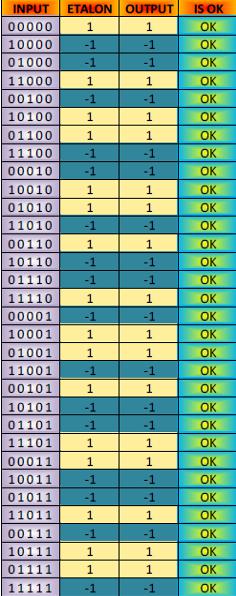
 20-Dimensional Rastrigin function minimization
20-Dimensional Rastrigin function minimization
 An example of result ... By Marchanka Ilya
An example of result ... By Marchanka Ilya
using 50 chromosomes with 20 genes. One without mutation (Left), and the other with mutation (Right).
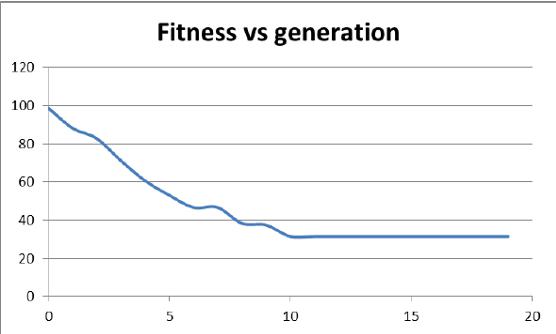
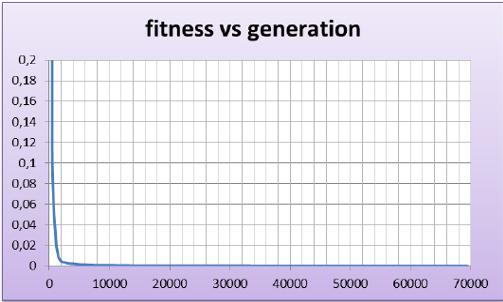
 Iterated Prisnner's Dilemma (IPD)
Iterated Prisnner's Dilemma (IPD)
 An example of result ... By Vechorko Anna
An example of result ... By Vechorko Anna
20 players each having 64-bit binary chromosomes. One game is made up of 12 rounds with 3 random preparation rounds + 9 serious rounds where 1 against 1 gets 5; 1 against 0 gets 2; 0 against 1 gets 0; and 0 against 0 gets 3 are counted in last 9 rounds. Each player plays with other 19 players in the population and Fitness is a total points of these 19
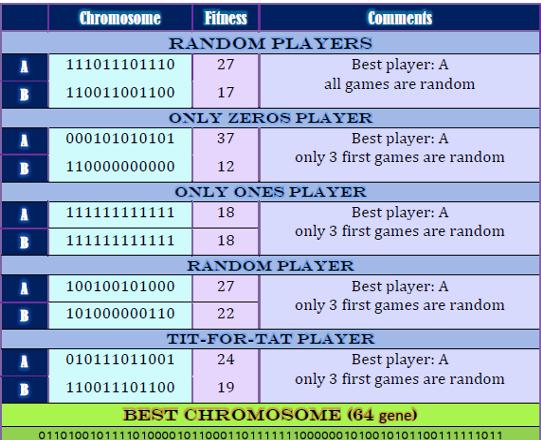
 Dimension reduction from 3D sphere to 2D circle
Dimension reduction from 3D sphere to 2D circle
 An example of result ... By Katolik Alexandr
An example of result ... By Katolik Alexandr
At the begining, a target 3D spere was created and select 20 points randomly from the surface.
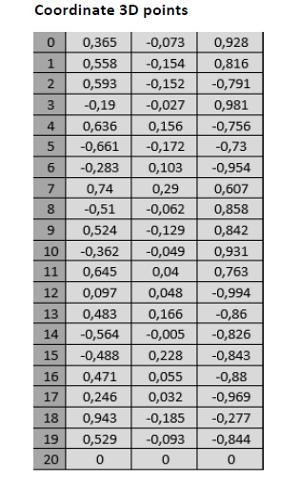

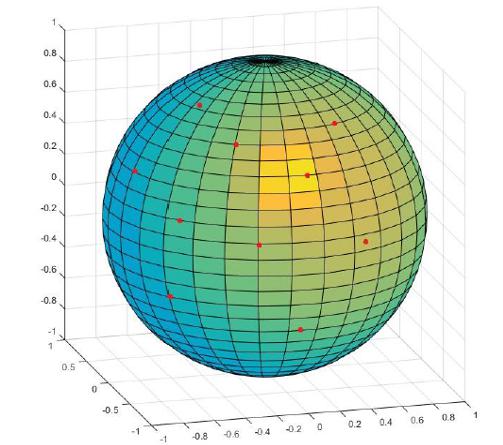
Then the original 3D distance matrix and its normalization were calculated.


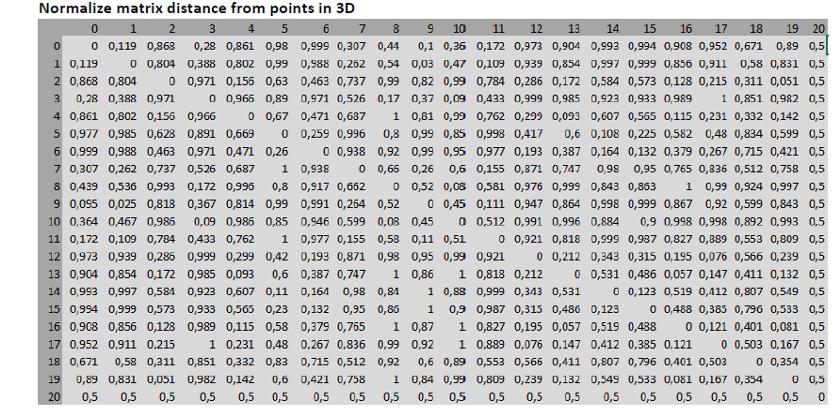
At the end of evolution, the 2D normalized distance matrix of the best chromosom was obtained.
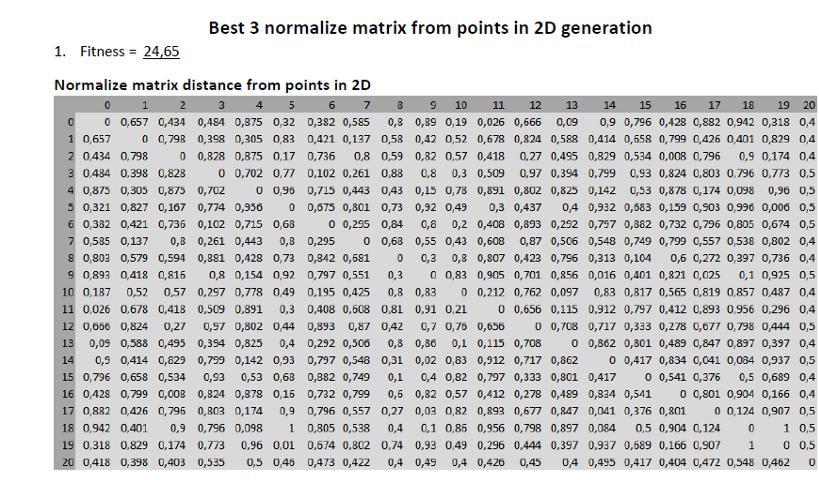
 Good work! But the final figure of those 20 points probably on the circle mapped from the original 3D target is missing. What a shame!
Good work! But the final figure of those 20 points probably on the circle mapped from the original 3D target is missing. What a shame!
 The curve of fitness vs. generation might be something like this ... By Belous Sophia
The curve of fitness vs. generation might be something like this ... By Belous Sophia
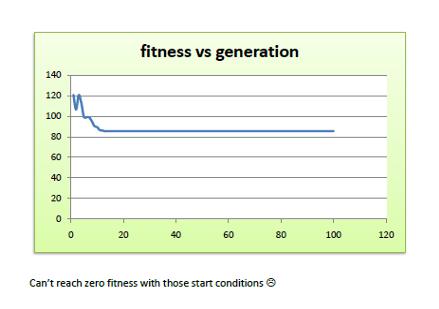
 It's O.K. if the best fitness was not 0. As small as possible is sufficient. Because of "The curse of dimension, the perfect mapping would not be almost impossible!
It's O.K. if the best fitness was not 0. As small as possible is sufficient. Because of "The curse of dimension, the perfect mapping would not be almost impossible!
 Dimension reduction from 10-D hyper-sphere to 2D circle
Dimension reduction from 10-D hyper-sphere to 2D circle
 The target 10 random points in 10-D hyper-sphere ... By Korol Andrew
The target 10 random points in 10-D hyper-sphere ... By Korol Andrew
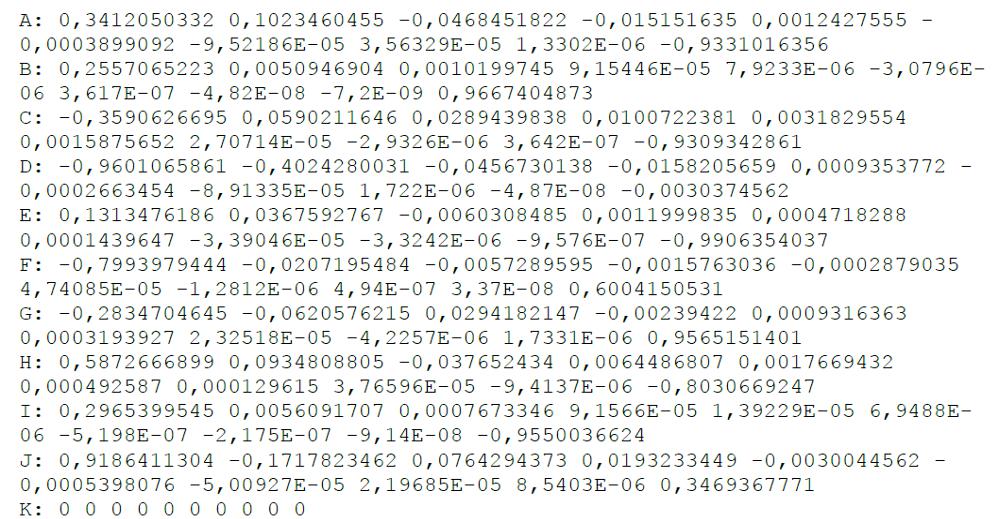
 No one except for him showed the target 10-D coordinates of 10 points chosen rondomly from 10-D hyper-sphere surface. But more elaborate way such as table will be better!
No one except for him showed the target 10-D coordinates of 10 points chosen rondomly from 10-D hyper-sphere surface. But more elaborate way such as table will be better!
 An example of the distance matrix of target 10 random points in 10-D hyper-sphere, and its normalized version ... By Radchuk Aliona
An example of the distance matrix of target 10 random points in 10-D hyper-sphere, and its normalized version ... By Radchuk Aliona
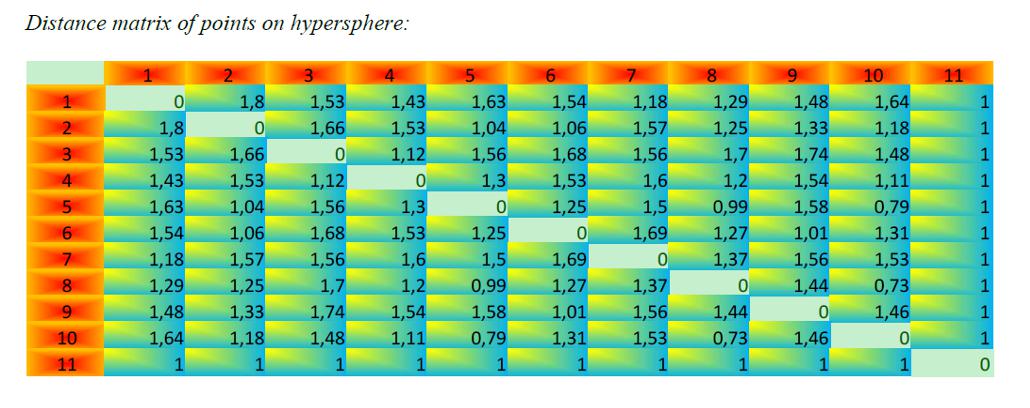
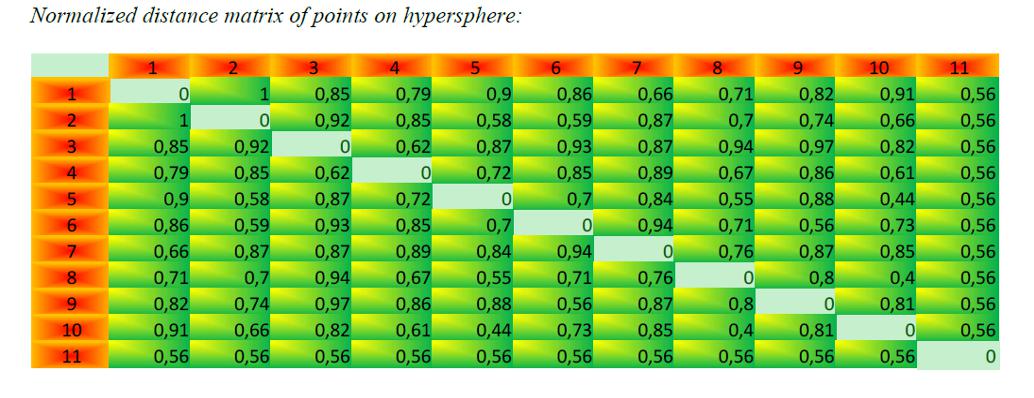
 Anyway two version of distance matrix of the target 10 points should be calculated such as this.
Anyway two version of distance matrix of the target 10 points should be calculated such as this.
 The result of 10 2-D points should be near the circle ... By Kabachuk Dmitry
The result of 10 2-D points should be near the circle ... By Kabachuk Dmitry
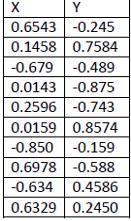

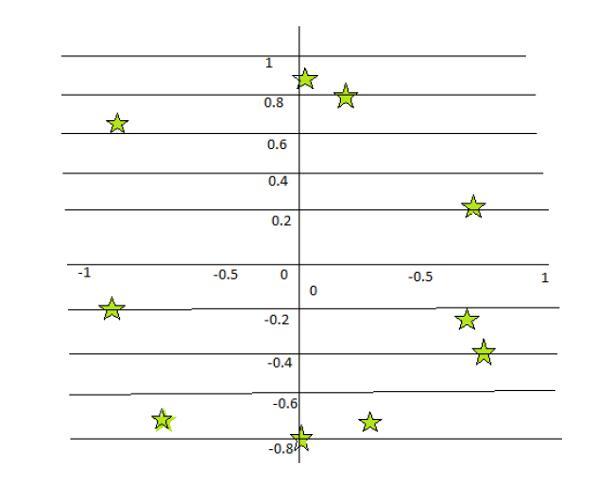
 His result was quite close to the solution but not so much so far!
His result was quite close to the solution but not so much so far!
 The fitness vs generation ... By Verenich Dmitry
The fitness vs generation ... By Verenich Dmitry
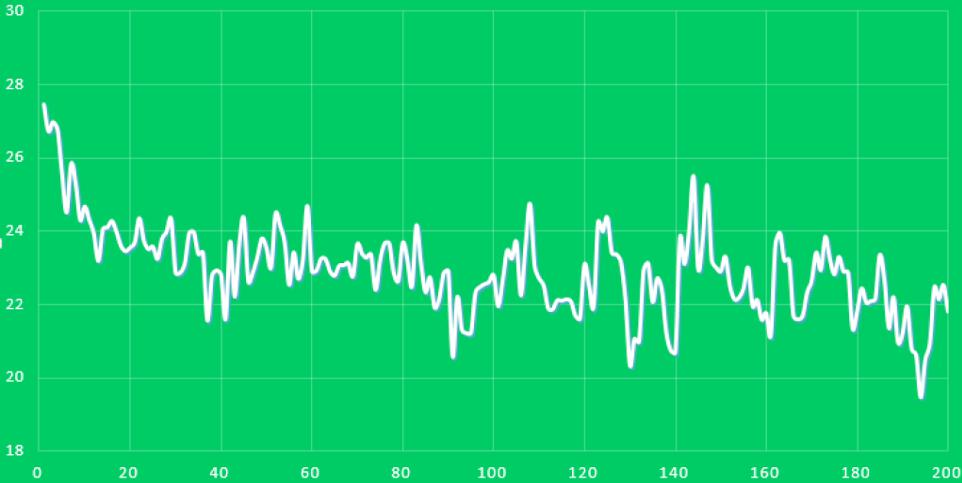
 Maybe he should be more patient to wait for the better result by repeating much more and more. Or something is wrong in the algorithm ...
Maybe he should be more patient to wait for the better result by repeating much more and more. Or something is wrong in the algorithm ...
 Dimension reduction from 5-D hyper-sphere to 2D circle
Dimension reduction from 5-D hyper-sphere to 2D circle
 A result ... By Soloduha Pavel
A result ... By Soloduha Pavel
The 20 points chosen at random from the surface of the target 5-D hyper-spere (Left), and their normalized distance matrix (Right)
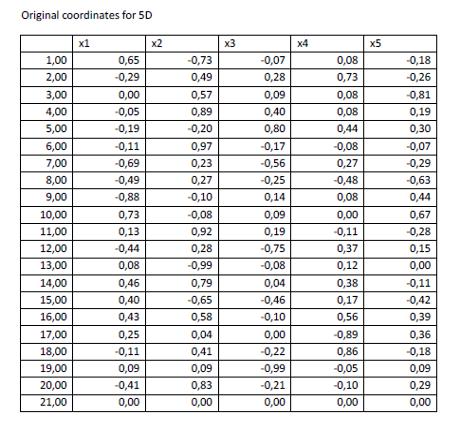

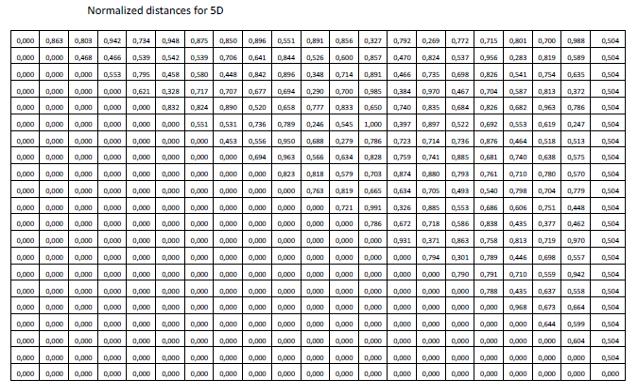
Fitness vs. generation (Left), and the points by the best chromosome (Right)
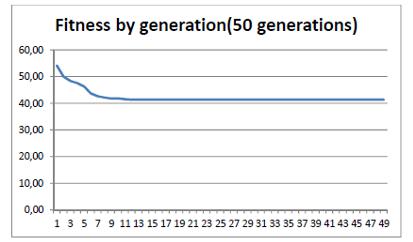

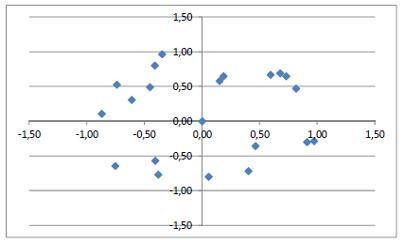
 Dimension reduction from 3-D cube to 2D square
Dimension reduction from 3-D cube to 2D square
 A result ... By Vechorko Anna
A result ... By Vechorko Anna
The 40 points chosen at random from the surface of the cube (Left), and its normalized distance matrix (Right)
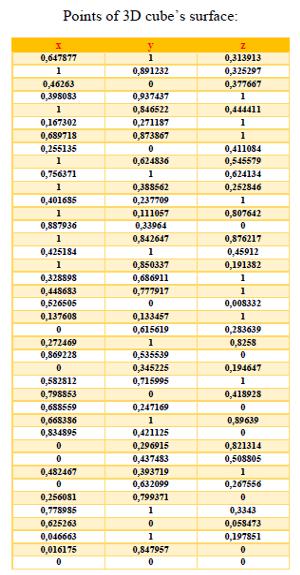

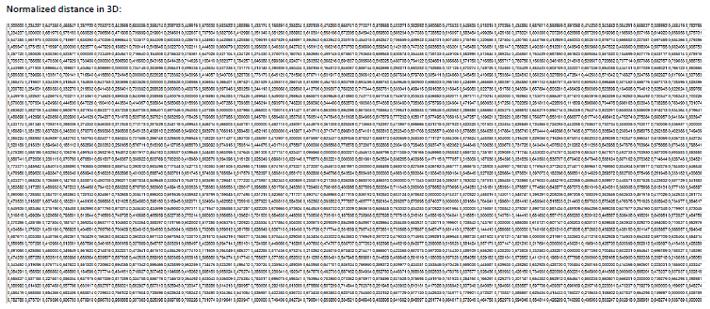
A set of 40 points in 2D of a random chromosome in the 1st generation (Left), and its graphics (Right)


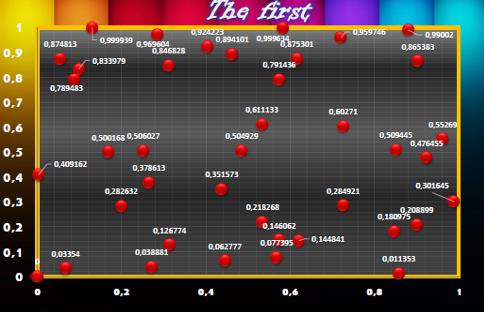
Fitness vs. generation
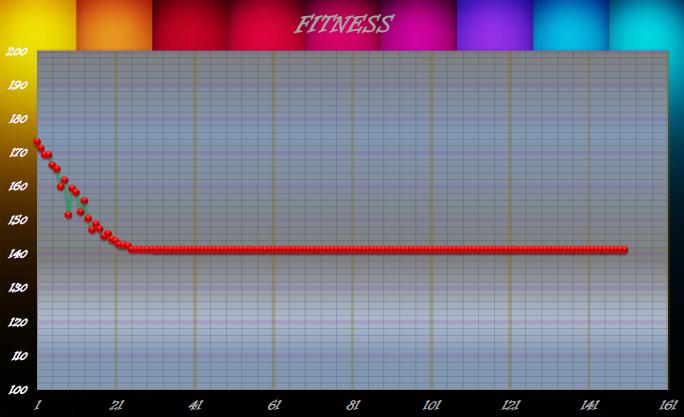
A set of 40 points in 2D of the best chromosome in the final generation (Left), and its graphics (Right)


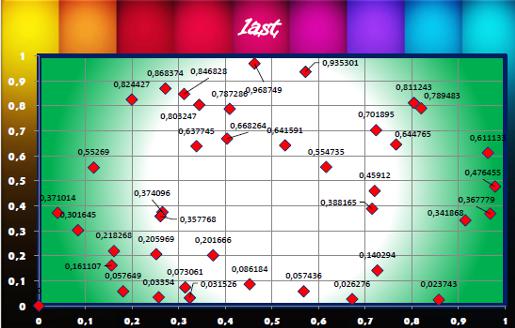
Its normalized distance matrix
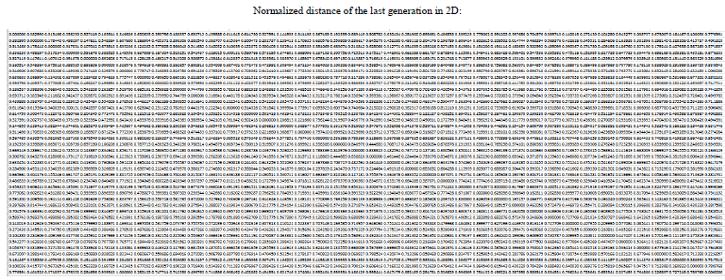
 A needle in a haystack problem
A needle in a haystack problem
N-digit passward breaking with N-bit chromosome whose genes are integer from 0 to 9.
 A result ... By Bakun Anton
A result ... By Bakun Anton
When fitness is number of match (max=N, min=0)
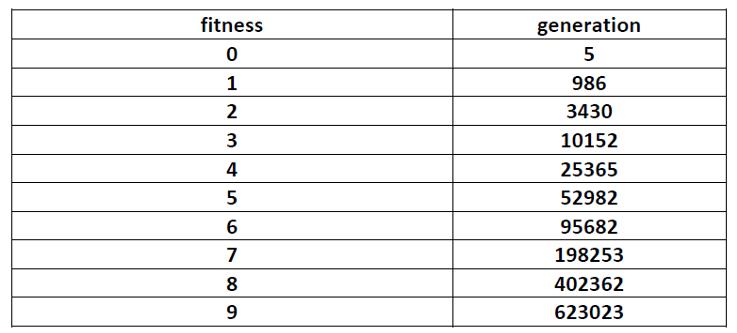

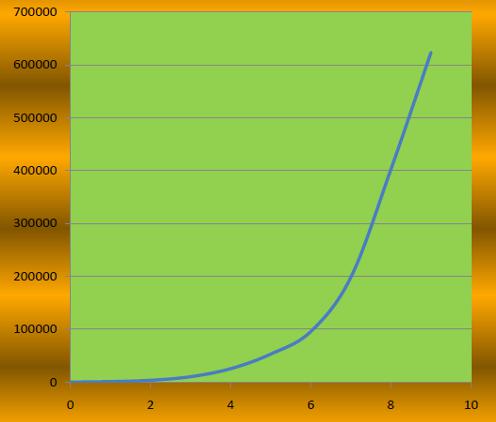
When fitness is match (fitness = 1) or not (fitness = 0) => This is "NEEDLE IN A HAYSTACK"
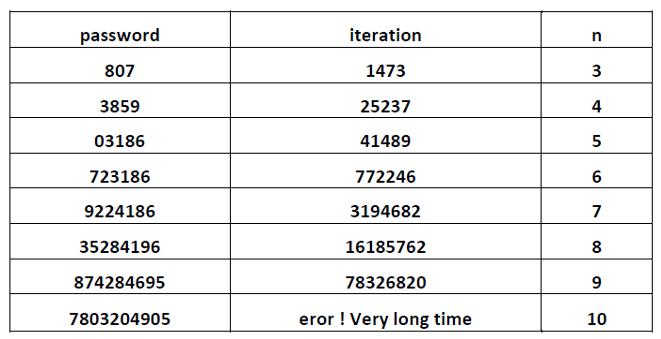

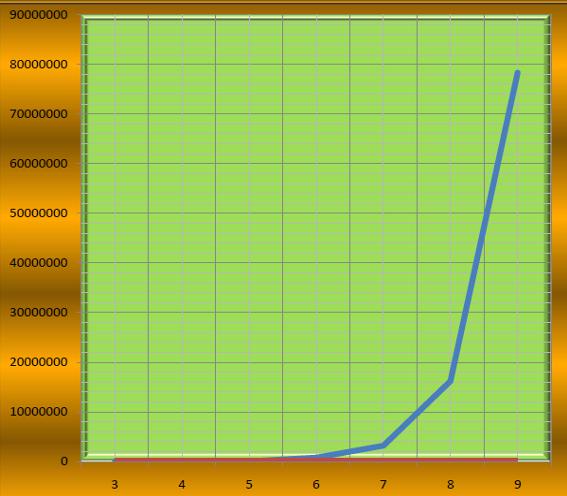
 A sorting network problem
A sorting network problem
 Try to observe how a random chromosome with 150 genes with each value being 01-16 can sort 16 integers from 1 to 16
Try to observe how a random chromosome with 150 genes with each value being 01-16 can sort 16 integers from 1 to 16
 An example 1. ... By Radchuk Aliona
An example 1. ... By Radchuk Aliona
A randomly created chromosome (Left), and its graphic representation (Right)
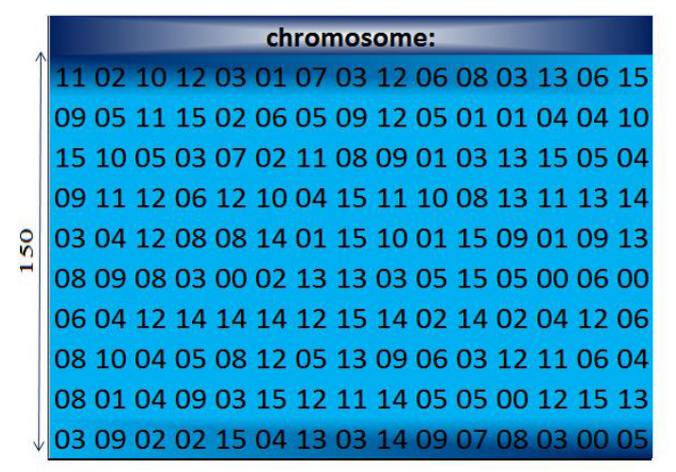
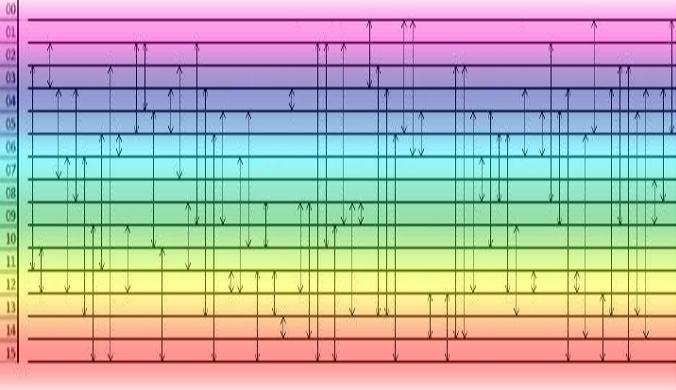
 Those indentical comparisons should be removed from the diagram. One comparison will be enough for a same pair! E.g. "11" and "12" are compared three times.
Those indentical comparisons should be removed from the diagram. One comparison will be enough for a same pair! E.g. "11" and "12" are compared three times.
 I found the 95th gene and the 96th gene are both 14, right? Then the comparison is meaningless in this case.
Then how many meaningful comparisons in the chromosome, after removing multipul identical comparisons and comparison between identical items.
I found the 95th gene and the 96th gene are both 14, right? Then the comparison is meaningless in this case.
Then how many meaningful comparisons in the chromosome, after removing multipul identical comparisons and comparison between identical items.
A result of applying the chromosome to a set of 4 random order of integers from 1 to 16.
The goal is to sort them from small to large.
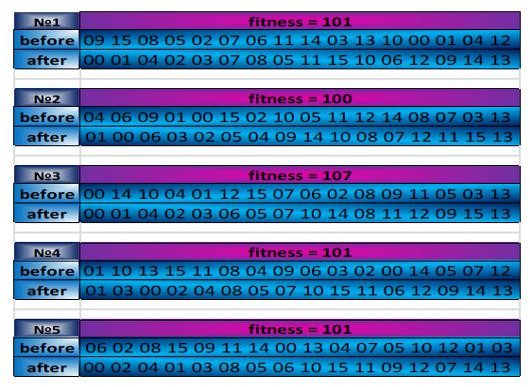
 An example 2. ... By Chepeleu Kiryl
An example 2. ... By Chepeleu Kiryl
His chromosome (Left), and its graphic (Right)

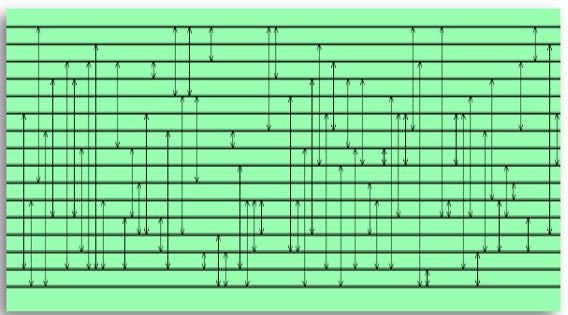
 The same. Remove multiple comparisons afte the first one!
The same. Remove multiple comparisons afte the first one!
His sorting 4 examples
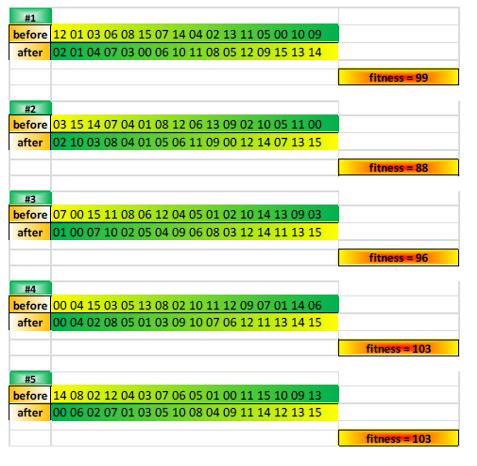
 Fitness is by {FOR i=1 TO N AND j=1 TO N IF x(i)>x(j) replace; ELSE do nothing}
Fitness is by {FOR i=1 TO N AND j=1 TO N IF x(i)>x(j) replace; ELSE do nothing}
 An example 3. ... By Supruniuk Darya
An example 3. ... By Supruniuk Darya
Her chromosome, and its graphic


 Remove multiple comparisons afte the first one!
Remove multiple comparisons afte the first one!
Her sorting 5 examples

 Sorting network by evolution with 40 binary-chromosomes with 960 genes (max 120 comparisons)
Sorting network by evolution with 40 binary-chromosomes with 960 genes (max 120 comparisons)
 An example ... By Marchanka Ilya
An example ... By Marchanka Ilya


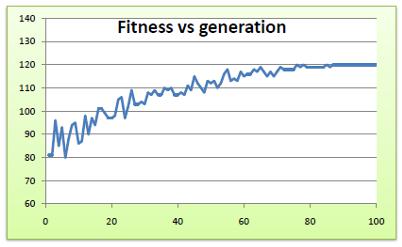

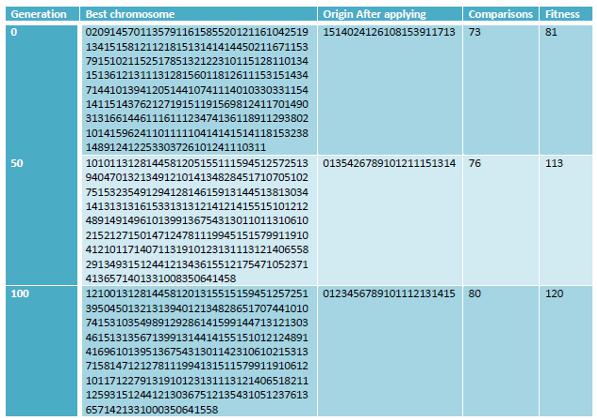
 Good work! But what was indicated was not by using interger chromosomes but binary ones!
Good work! But what was indicated was not by using interger chromosomes but binary ones!
 How
a
diploydy chromosome of length 480 genes sort string of 16 letters to alphabetical order? (also max 120 comparisons)
How
a
diploydy chromosome of length 480 genes sort string of 16 letters to alphabetical order? (also max 120 comparisons)
 An example ... By Koroluk Andrew
An example ... By Koroluk Andrew
His diploydy chromosome created at random


Actual comparisons that his diploydy chromosome above means are:


Then this diploydy chromosom compares the 16 letters one pair after another and exchange if necessary
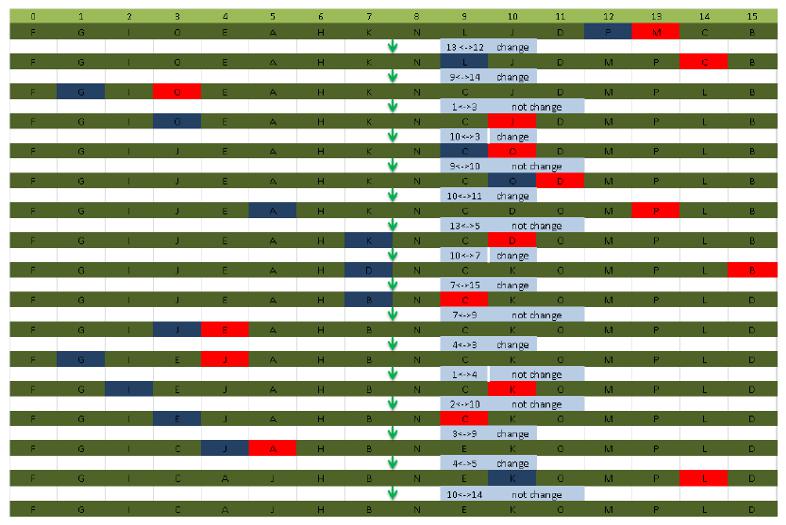
 Beautiful! But unfortunately his diploydy chromosome is only a pair of 64-bit length while what was indicated was 480-bit length
Beautiful! But unfortunately his diploydy chromosome is only a pair of 64-bit length while what was indicated was 480-bit length
 Yet another example ... By Belous Sophia
Yet another example ... By Belous Sophia
Her diploydy chromosome created at random and its decimal interpretation
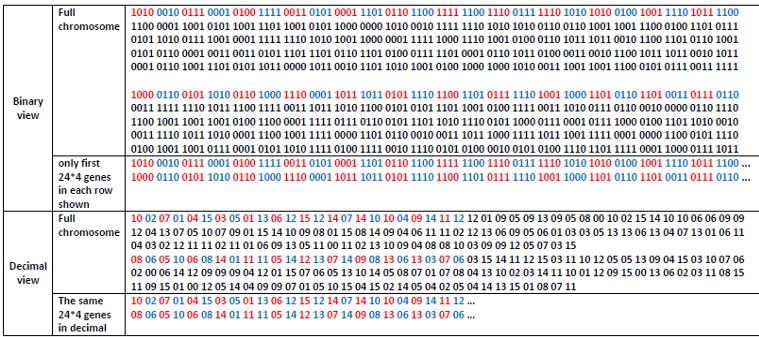

Her target string of 16 letters, its sorted result, how good is this sorting (= fitness), the number of actual comparisons, the number of removed comparisons due to multiple comparisons of a same pair and self comparisons, and the number of self comparisons


The diagram of comparisons of her diploydy chromosome

 Sorting network with
Diploydy chromosomes
by evolution with a pair of binary-chromosomes with 480 genes (max 120 comparisons)
Sorting network with
Diploydy chromosomes
by evolution with a pair of binary-chromosomes with 480 genes (max 120 comparisons)
 An example ... By Marchanka Ilya
An example ... By Marchanka Ilya

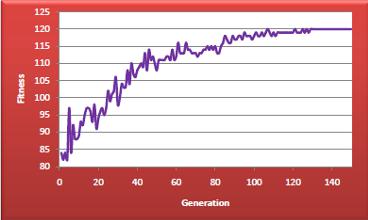
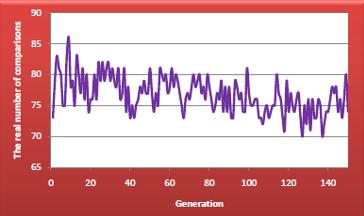

 Biologicaly (0-0) & (1-1) pair tend to inclease, and as such, real nubmer of comparisons decreases in this case, which I expected the same goes here but not indeed, for some reason we don't know...
Biologicaly (0-0) & (1-1) pair tend to inclease, and as such, real nubmer of comparisons decreases in this case, which I expected the same goes here but not indeed, for some reason we don't know...




 Yet anothethr result - best cromosome and its diagram ... By Kuchur Alexander
Yet anothethr result - best cromosome and its diagram ... By Kuchur Alexander


